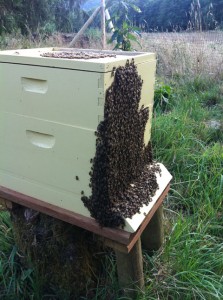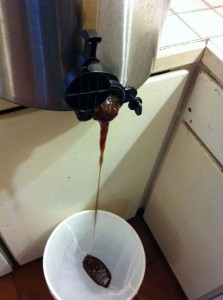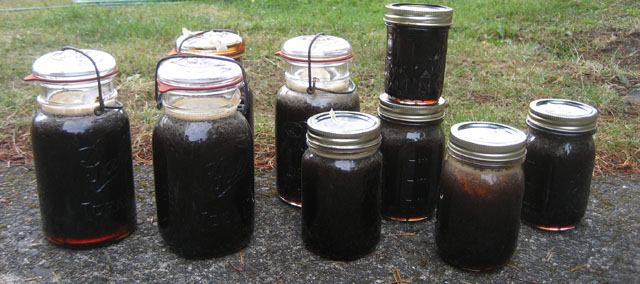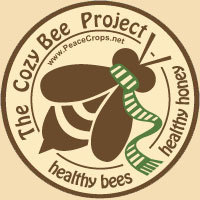…or, rather, honey that came as a surprise. Last Tuesday I popped out to the hives to do a mite inspection, and noticed to my horror that Colony A was in the middle of swarming. This is a disaster, because unlike the spring swarm where you can get two colonies if you are careful, the fall swarm weakens both colonies without giving them enough time to rebuild before the coming cold, leaving neither much chance of making it through the winter. Ugh.
 But, luckily for me, that particular Tuesday was the beekeeper’s meeting, and Terry and I usually carpool there. We passed the farm on the way out, so I asked him if he’d take a look.
But, luckily for me, that particular Tuesday was the beekeeper’s meeting, and Terry and I usually carpool there. We passed the farm on the way out, so I asked him if he’d take a look.
“That’s not a swarm,” he said. “That’s bee bearding. Is your hive honeybound?”
Honeybound is when the hive is so full of honey that there’s no more room for the bees to work. I’m a bit embarrassed to admit that’s exactly the situation here; last time I checked, there was a lot of space left, and I was worried that the bees would not have enough honey to eat for the winter. But in the last three weeks, the bees have worked with a purpose and harvested some odd, blood-red honey and PACKED THE HOUSE with it.
Terry’s solution? Pull a few frames out of each hive body, and extract honey! This gives the bees more space, and gives me an unexpected honey crop after all.
 At the beekeepers’ meeting, the blood-red honey was a hot topic. Richard got some too, and mentioned that it turns dark brown once you extract it and expose it to the air. Dark honey is also a premium product, it seems, fetching a higher price for its especially flowery taste. There’s some debate as to where the dark honey comes from; Terry thinks it comes from the Japanese Knotweed, a pernicious invasive species that covers the local riverbanks and blooms in late August. Some internet research supports this theory; that honey is called “bamboo honey” and tastes somewhat like buckwheat honey. Richard says it might come from the honeydew of various poplar species, though I couldn’t substantiate that. Regardless, it’s supposed to be loaded with antioxidants, giving even more health benefits than regular honey, according to this source.
At the beekeepers’ meeting, the blood-red honey was a hot topic. Richard got some too, and mentioned that it turns dark brown once you extract it and expose it to the air. Dark honey is also a premium product, it seems, fetching a higher price for its especially flowery taste. There’s some debate as to where the dark honey comes from; Terry thinks it comes from the Japanese Knotweed, a pernicious invasive species that covers the local riverbanks and blooms in late August. Some internet research supports this theory; that honey is called “bamboo honey” and tastes somewhat like buckwheat honey. Richard says it might come from the honeydew of various poplar species, though I couldn’t substantiate that. Regardless, it’s supposed to be loaded with antioxidants, giving even more health benefits than regular honey, according to this source.
The next day, I took a few frames of honey from the center of the hive, as Terry advised, and extracted the honey from them. Richard let me borrow his extractor, which is basically a centrifuge made to spin frames of honeycomb. The honey runs out the bottom, and the sticky-but-empty combs can be put back in the hive for the bees to clean and reuse. Here is a picture of my dark honey as it goes into the bucket strainer. Terry warned me that a few frames gives a lot more honey than you’d expect, and he was right: my seven frames yielded just over six quarts of sweet honey goodness. Mmmmm.That’s not enough to sell, but that’s OK- it’s way more than I expected this year, and besides giving us plenty for household use, allows me to fill a few karmic duties and provide gifts to some of the peole who have really helped us out this year.



2 Responses to Surprise, honey!